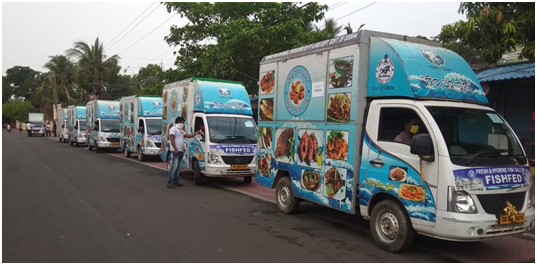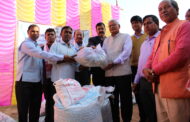Dr. B. K. Das, Dr. B. K. Behera & Dr. P. K. Parida
Introduction
Fishery in inland open water sector occupies a unique status in the national economy and provides livelihood, food and nutritional security and ecosystem services to the growing population in the country. The country is blessed with vast inland open water resources in terms of 0.19 million Kms of rivers and canals, 0.3 million ha of estuaries, 0.19 million ha of backwaters and lagoons, 3.51 million ha of reservoirs, 0.354 million ha of floodplain wetlands and 0.72 million ha of upland lakes. There are 14 larger rivers, 44 medium rivers, and innumerable small rivers present in India.
The reservoirs are classified into large (>5000 hectares), medium (1001 – 5000 hectare) and small reservoir (<1000 hectare). There are 56 large reservoirs having a water area of 1140268 hectares, 180 medium reservoirs having a water area of 527541 hectares and 19134 small reservoirs having a water area of 1485557 hectares.
The estimated demand of fish by 2025 in the Indian domestic market would be around 16 million tonnes (MT) against the present production of 13 MT coming from inland (65%) and marine (35%) sectors. These resources provide employment and livelihood support to 1.24 million inland fishers. However, the outbreak of COVID-19 and the resultant total lockdown in India has greatly affected the Inland Fisheries Sector in India. The total lockdown may help in restricting the spread of corona virus; however, quick and effective intervention is required for fishers to minimize the disruptive effect on the livelihoods of vulnerable population particularly on food systems, storage and market chains, both locally and regionally.
ICAR-CIFRI has surveyed the impact of COVID-19 in few states in India and the case studies are given below.
Impact of COVID-19 in Sundarban
Three fishing villages and 3 fish markets in Gosaba block of North 24 Paraganas of Sundarban area were surveyed on the impact of COVID-19 in fisheries activities. Ninety four households were surveyed on the impact of COVID-19 on individual household fisheries activities. During the Market survey, it was observed that, the volume of fish trade has been reduced to 33% of the volume.
The price of fishes has been increased to 1.25 times for IMC and Medium carps, where as the price of other commercial species available in the estuarine zone has been decreased to less than 50% as they are mostly supplied to the bigger market in urban areas. The price of small indigenous fishes has been reduced to 25 – 50%. The decreasing in price of other commercial species is due to non availability of marketing channel.
The fishing scenario in the Sundarban Area was observed that, only 10% boats are operating for fishing. Again there is reduction in 50% in total members in each boat. The fishing days has been reduced to 33%. However, in each boat, the 50% increase in fish harvest was observed. The market channel is not available and ice is also not available locally for fish transport. Fishermen forced to sell the fish in local market at a cheaper price.

Fig. 1 Survey at the fish farm in Sundarban (Photo courtesy: Mr. Mustafa, Secretary, Sunderban dreams)
Fish marketing initiative of Odisha during COVID-19
“Chilika Fresh” is a modern fresh fish outlet which is the brand name developed by Fisheries Department, Government of Odisha and managed by FISHFED, Odisha to provide fresh fish to the consumers of Odisha. During the lockdown, when people are not willing to come out of their house, the Odisha FISHFED has started a new initiative by providing fresh fish through door to door services using fish on wheel. FISHFED, Odisha has not tried to increase the price of the fish, when there is an increase in fish price in the market particularly the IMCs. There is a huge demand by the urban consumer for the fish from “Chilka Fresh” as it is providing door to door service through “fish on Wheel” and at an affordable price. At present, there are 10 numbers of “Fish on wheel” vehicle running in Bhubaneswar city to provide fresh fish to the urban consumers.

Fig. 2 Fish species sold in Fish on wheel in Odisha at the doorstep (photo courtesy: Mr. B. B. J. Sahoo, AFO, Fisheries Department, Govt. of Odisha)
Table 1. Fish species sold in Fish on wheel and their price in Odisha
| Sl. No. | Fish species | Price (Rs.)/ Kg |
| 1 | Catla catla (Live) | 190.00 |
| 2 | L. rohita (Live) | 160.00 |
| 3. | L. clacarifer (Bhetki) | 550.00 |
| 4. | T. illisha (Hilsha) | 1000.00 |
| 6. | Mullets | 440.00 |
| 7. | Pomfret | 850.00 |
| 8. | Smaller mullets | 160.00 |
| 9. | Polynemidae sps. | 240.00 |
| 10 | L. bata | 180.00 |
| 11. | Small Indigenous fishes | 180.00 |
| 12 | P. monodon | 550.00 |
| 13 | L. venamei | 400.00 |
| 14 | P. indicus | 450.00 |
| 15. | M. rosenbergii | 550.00 |
| 16. | Smaller prawns | 260.00 |
| 17. | Mackerel | 100.00 |
| 18 | Lesser sardine | 100.00 |
Odisha state has taken a very good initiative in maintaining social distance in fish markets. Nimapda retail fish market in Pipili block of Puri district in Odisha, the daily fish market maintain the social distancing during the selling of fish in the retail market. The municipality has marked circles with a distance of 1 meter from each other in the retail fish market.

Fig. 2 Nimapda retail fish market in Pipili block of Puri district in Odisha (Photo courtesy: Ms. Soudamini, JFTA, Fisheries Department, Govt. of Odisha )
Conclusion
Lockdown due to Covid-19 has affected the fish value chain throughout India. The required fish seed, fish feed and other accessories were not available to the fishers/ fish farmers at the required time during the lock down. The fish supply chain has also got affected due to lockdown. The price of freshwater fishes like IMCs have increased in the markets of Odisha, West Bengal and Bihar, due to the hike in demand and the major chunk of the profit taken by the local fish sellers rather than the fishermen. Though fishing ban was not there in inland fisheries sector during lockdown, but large scale fish production form inland open waters were not conducted due to maintenance of social distance. The lockdown has affected the livelihoods of millions of inland fishers in India and also the fish production from inland sector.
(Dr Das is the Director, ICAR-CIFRI, Barrackpore and B. K. Behera and P. K. Parida are working as Principal Scientists. Views expressed are personal.)
(Please share your experience, interesting articles and case studies at aquapostnews@gmail.com)






